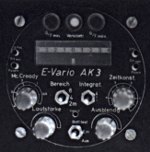AK-3

At the beginning of the 1970s, the Akaflieg Karlsruhe wanted to improve the instrumentation of the aircraft. In particular, a variometer that corresponded to the state of the art at the time would have been very helpful for cross-country flying. However, as good electronic variometers were too expensive, the Akaflieg had to build the instruments themselves.
The first theoretical considerations for a flight data computer began in the summer of 1972. The first model was created: in addition to an electric variometer, the computer was to contain a target speed sensor, a net variometer, an analog mean value display to show the average climb rate and a command sensor to turn into an updraft field in good time. The mathematical operations required could be easily reproduced under laboratory conditions with analog circuits, but the installation in a small, compact device, which also had to operate with low power consumption, posed considerable problems.
Components designed for low power consumption, low operating voltages and extreme environmental conditions (temperature, humidity) were too expensive. Therefore, the decision was made to build an electric variometer with a setpoint sensor in which the necessary operations were realized pneumatically as far as possible.
This resulted in the first version of the AK-3 in 1975, which included an acoustic display and a moving-coil instrument. A metal wire probe from Westerboer was used as the flow measuring probe. However, moving coil instruments have the disadvantage that the strong magnetic field can influence the compass and the display is dependent on vibration and acceleration. A linear scale consisting of 16 LEDs was therefore selected for the second version.
The use of a special color filter and light-emitting diodes with particularly high efficiency made the display legible even in the light conditions in the cockpit.
The final version of the set speed variometer was finally developed in 1978. In order to further reduce power consumption, a liquid crystal display developed in-house was used. In addition, two self-developed flow measuring probes were used. The AK-3 also has the option of connecting an electronic final approach computer.
The AK-3 variometer subsequently proved itself in numerous cross-country flights and was even produced in a small series, so that examples are still occasionally traded on the used instrument market today.